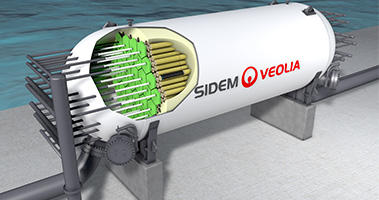A safe, compact and digital RO desalination system. Its plug-and-play approach helps to secure a fast-track schedule while its embedded digital sensors provide remote monitoring.
Info general
El Barrel fue introducido en el mercado por SIDEM -filial de Veolia Water Technologies- en 2019 como una gran innovación para la desalinización de agua de mar; sin embargo, pronto se hizo evidente que la tecnología también abordaba perfectamente los desafíos asociados a la reutilización del agua.
Cómo funciona el Barrel
El Barrel permite que la implementación del proceso de ósmosis inversa sea estrictamente idéntica a la de los recipientes a presión de ósmosis inversa actuales. Esto garantiza que el agua dulce producida cumpla todas las normas de calidad del agua desalinizada para los mercados municipales e industriales. También es adecuado para la reutilización de aguas residuales y aplicaciones de ósmosis inversa a baja presión.
Its carbon steel pressure vessel is manufactured and tested off-site, and is delivered as a single unit so installation on-site can be fast-tracked and project schedules shortened.
In addition, its modular design makes it highly scalable, offering varying capacities from 400 to 50,000 cubic meters a day per unit. It can also be used in place of existing RO membranes and nanofiltration skids for a more economically viable, sustainable and innovative alternative.

Compact and suitable for outdoor installations, the Barrel offers a footprint reduction of up to 25 percent and does not require a controlled environment. The sustainable solution also provides a reduction in electrical consumption in the range of 0.05 kilowatt-hour per cubic meter of fresh water produced.
Meeting the demand for clean water has never been more challenging but the Barrel helps our customers secure their supplies by creating an economically viable and sustainable source of freshwater.


Reliable production of the same quality as fresh water but at a lower cost.

Economically viable and sustainable source of fresh water.

Easy to operate, it allows remote diagnostics and predictive maintenance thanks to its embedded digital devices.

Reuse of treated wastewater creates a new water cycle in a planned and supervised way.
Aplicaciones
Servicios
Contacto
The Barrel is more than a means to take salt from seawater. It is a reverse osmosis or nanofiltration technology that has the power to solve many of our water resource issues, from securing residential drinking supplies to helping to ensure business resilience as the demand for water sharply rises. And after treatment, wastewater (municipal or industrial) becomes too valuable to dispose of and so we use the same technology to facilitate its reuse.

Elodie du Puytison
Product Manager — Barrel
Contact Elodie through her LinkedIn account
FAQ about Barrel™
What is desalination?
Desalination uses reverse osmosis membranes to separate salt and other molecules from seawater. Seawater is pushed through hundreds of tightly-wrapped, semipermeable membranes under very high-pressure. The membranes allow water to pass through, leaving salt and other molecules and impurities behind.
Why is desalination so important?
By 2040, it is estimated one in four children worldwide will be living in areas of extremely high water stress; however, water scarcity already has far-reaching consequences today. From Qatar and Saudi Arabia to Spain and Australia, large parts of the world are already feeling the impacts of climate change on their water resources. Desalination is an effective way of tackling water scarcity issues in arid coastal areas and secondly by facilitating water reuse.
How can water reuse combat water scarcity?
By removing dissolved solids and unwanted minerals from wastewater the same reverse osmosis-based technology means the water can be recycled several times, reducing the environmental impact of extracting fresh water. Water reuse has such a huge potential in addressing global water scarcity, it is cited as an official means of achieving Sustainable Development Goal six which focuses on ensuring the availability and sustainable management of water and sanitation for all. As a result, reuse is becoming a legal requirement in many countries.
Casos estudio

Reutilización de aguas residuales tratadas para la producción indirecta de agua potable, una primicia en Europa. El barril, con una capacidad de 3.600 metros cúbicos al día, ha sido entregado en el emplazamiento. El proyecto completo está ahora en construcción, las pruebas empezarán





